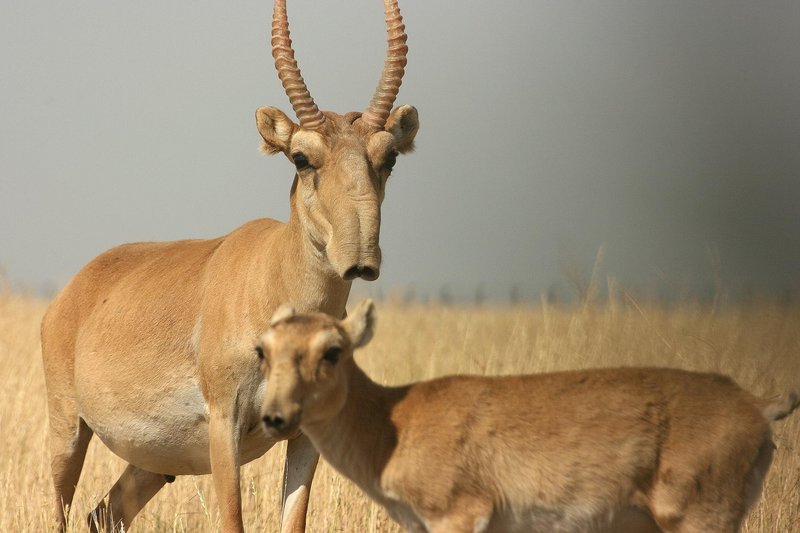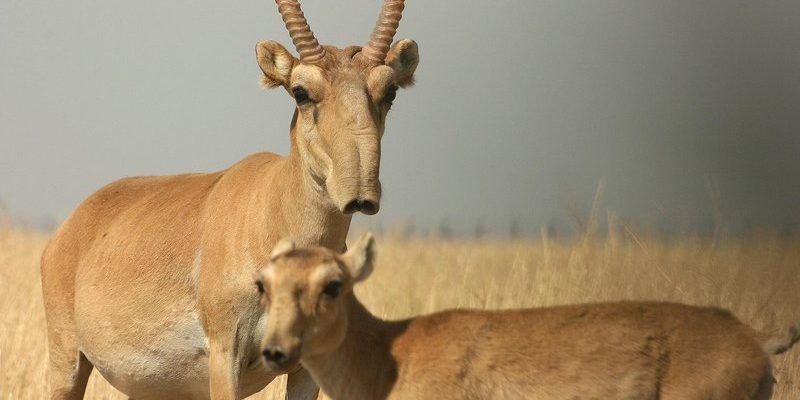
In a world where many antelope species face threats from habitat loss and hunting, the saiga stands out not just for its odd looks but also for its resilience. With their distinctive bulbous noses, sometimes called “snotty noses,” these antelopes have evolved in ways that help them adapt to their harsh environments. So grab a cup of coffee, sit back, and let’s explore the quirky and remarkable world of the saiga antelope!
1. Unique Physical Features
One of the most striking features of the saiga antelope is its large, floppy nose. It might look silly, but there’s a method to this madness! Their noses are specially designed to help filter dust and regulate their body temperature during the extreme climates of their homeland. Think of it like a built-in air conditioner! During the hot summers, these noses help cool the air before it reaches their lungs, ensuring they can breathe comfortably even in the blazing heat.
Now, let’s not forget about their incredible horns. Male saiga antelopes sport long, curved horns that can grow up to 30 inches in length. These horns are not just for show; they play an important role during mating season. Males will often spar with each other, using their horns to establish dominance and attract females. It’s nature’s equivalent of a friendly competition!
2. An Unusual Mating Ritual
Speaking of mating, the saiga antelope has some pretty unique courtship behaviors. During the breeding season, which usually occurs in late winter to early spring, males gather in large groups. They engage in a fascinating display of vocalizations and physical posturing to attract females. Picture a group of enthusiastic singers trying to impress an audience—only, in this case, the audience is the female saiga!
What’s even more interesting is that female saigas are quite selective. They often choose mates based on their size and the quality of their displays. It’s like a talent show, where only the best performer gets to win the prize. After mating, females typically give birth to one or sometimes two calves after a gestation period of about five months. These little ones are incredibly cute and become fully mobile just hours after being born, ready to explore their new world.
3. Saiga’s Habitat and Distribution
Saiga antelopes are primarily found in the semi-arid grasslands and steppes of Central Asia, particularly in countries like Kazakhstan, Mongolia, and Russia. They have adapted to live in these open landscapes, where they can escape predators and graze on grasses and herbs. These regions might seem barren, but they provide the necessary conditions for saigas to thrive.
However, their range has drastically shrunk over the years due to various factors, including climate change and human activity. You might be wondering how this affects the saiga: well, less habitat means fewer resources, making it harder for them to survive. Conservation efforts are underway to help protect their remaining populations and restore their habitats, but it’s a tough battle.
4. Social Behavior and Herd Dynamics
Saiga antelopes are highly social animals, often found in large herds ranging from a few dozen to several hundred individuals. These herds provide protection against predators like wolves and eagles. Just like in a bustling city, being part of a group can make survival easier, as there are more eyes to spot danger.
Within these herds, social structures can be complex. Females and their young typically hang out in larger groups, while males often form smaller bachelor groups. Honestly, it’s like high school all over again, where the boys hang out with each other, and the girls form their own cliques! During the mating season, males will join the female groups to compete for attention, showcasing their strength and skills to win the ladies over.
5. Diet and Foraging Habits
The diet of saiga antelopes mainly consists of grasses, herbs, and shrubs. Their unique dental structure allows them to efficiently graze and select the most nutritious plants. Think of them as picky eaters, but in the wild! They often travel long distances in search of food, especially during periods of drought when grass becomes scarce.
Interestingly, saiga can also adapt their diets based on seasonal availability. During the summer months, they may switch to eating more shrubs and twigs when grasses are less available. This flexibility is essential for their survival, allowing them to make the best of a challenging environment.
6. Threats to Survival
Sadly, saiga antelopes face numerous threats that have led to a significant decline in their populations. One major issue is poaching. Their horns are highly sought after in traditional medicine, particularly in some Asian cultures. This demand creates a dangerous situation for saigas, as hunters target them for their valuable horns.
Habitat loss is another significant threat. As agriculture expands and urban areas grow, the open grasslands that saigas rely on for food and shelter are disappearing. Honestly, it’s a tough time for these animals, and conservationists are racing against the clock to rally efforts to protect their habitats and reduce poaching.
7. Conservation Efforts
The good news? There’s hope! Many organizations and governments are working tirelessly to save the saiga antelope from extinction. Conservation programs focus on two main strategies: protecting their habitats and cracking down on poaching. This might include creating protected areas and raising awareness about the importance of saigas in their ecosystems.
Community involvement is also crucial. Educating local populations about the saiga and the benefits of protecting them can go a long way. After all, when people understand the significance of these animals, they’re more likely to support conservation efforts and make sustainable choices.
8. The Future of the Saiga Antelope
The future of the saiga antelope hangs in the balance, but with dedicated conservation efforts, there’s room for optimism. Researchers are closely monitoring their populations and working on initiatives to restore their habitats. Every small victory counts! With more awareness and support, it’s possible that saiga numbers can bounce back, giving these quirky antelopes a fighting chance.
Imagine a future where saiga antelopes roam freely in healthy, thriving habitats. Wouldn’t it be heartwarming to see them flourish again? Each of us can contribute to their conservation through advocacy and responsible choices.
In conclusion, the saiga antelope is a truly remarkable creature, full of surprises. From their unique physical features to their fascinating social behaviors, these animals have captured the hearts of many. By understanding their importance and supporting conservation efforts, we can help ensure that future generations get to marvel at these extraordinary animals.
Let’s work together to keep the saiga antelope thriving in the wild!

